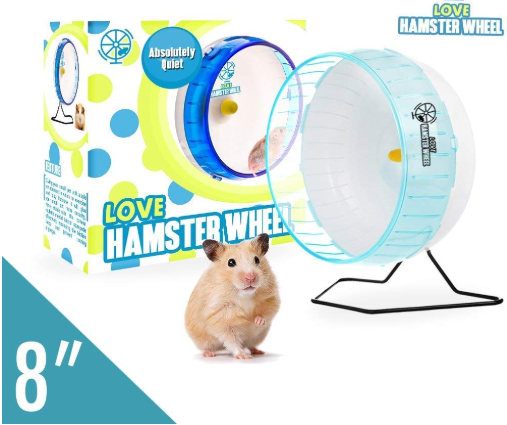A hamster wheel is a popular cage accessory and most hamster cages now come with one already built-in. Hamsters were born to run so they absolutely love exercise wheels and can cover huge distances when running through the night!
But do hamsters need a wheel? And why do hamsters like to run so much? We’ll answer everything below.
Do Hamsters Need An Exercise Wheel?
In short, yes! At first sight a hamster running on a wheel may seem like an unnatural behaviour and perhaps a negative response to being in captivity, but that couldn’t be further from the truth. Why do hamsters need exercise wheels? It really comes down to matching the behaviours of hamsters in the wild.
Did you know: Hamsters have been known to run around 5-6 miles (10km) every single night!
Here are some examples of good hamster wheels:
Hamsters In The Wild
Both Syrian and dwarf hamsters will cover miles and miles of distance at night when in their natural habitat. Hamsters surface from their burrows once the sun has set to scavenge for food and nesting materials in the nearby area.
This scavenger instinct is very natural and it’s one of the reasons why hamsters have such high energy levels – they’re built to run! It’s important to fulfil this instinct when looking after your own hamster and the best way to do this is with a hamster wheel.
Why Do Hamsters Love To Run On Wheels?
Hamster wheels allow hamsters to cover the miles and miles of distance they would in the wild, within the confined space of a cage. Despite most cages having a small surface area, a hamster can still release all the energy it needs using an exercise wheel.
Hamsters have an instinct to run and the exercise wheel is the best way to fulfil this natural behaviour. Wheels also help reduce boredom as this can often become a problem for hamsters that are kept in a cage with few toys or opportunities for exercise. Just like us, it’s important for a hamsters to burn some calories now and again to maintain a healthy weight.
It’s also believed that running on a wheel satisfies some of a hamster’s natural curiosity and their love of exploring (which they can’t always do in a cage).
Benefits Of A Hamster Wheel:
- Fulfills your pet’s natural running instinct
- Helps keep your hamster healthy
- Helps avoid hamster obesity
- Allows your hamster to release its natural energy
- Reduces boredom caused by living in a confined space
How To Choose A Good Exercise Wheel For Your Hamster
Remember, hamsters are nocturnal which means they become active at night. The last thing you want is a squeaky wheel keeping you up all night! Luckily, there are now a range of silent hamster wheels available so you can sleep in peace while your hamster burns through those calories
It’s also important to choose a wheel that is stable and unlikely to topple over while in use. Some wheels will fix to your cage while others have a built-in stand. Either option is fine as long as the wheel is built well and doesn’t fall over easily. You can always bury the stand in your substrate to add some stability.
Always try to avoid hamster wheels that have small holes or gaps where your pet will be running. Hamsters have small feet that can easily become trapped and wheels with holes can easily cause injuries.
Not all wheels are made equal! It can be worth spending a few extra dollars on a hamster wheel that is durable and likely to last for the lifetime of your pet. Some of the better wheels also use non-slip materials as an extra safety measure.
Here is an ideal silent hamster wheel for your pet:

Here’s a quick summary of what to look for in a wheel:
- Use a silent wheel (or you’ll be up all night!)
- Very stable and unlikely to topple over when in use
- Avoid wheels that have holes or gaps on the running surface
- Spend a little extra for a durable wheel that’s built to last
- Wheels that use non-slip materials are ideal
A Note On Wheel Sizes
Hamster wheels come in different sizes and it’s important to pick the right one for your pet. The best way to find out of your wheel is big enough is to observe your pet while running. Your hamster’s back should be straight while it runs and not bent or slanted as this can lead to injury.
Here are some good minimum sizes for hamster wheels:
- 6.5 inches for dwarf hamsters
- 8 inches for syrian hamsters

Hamster Wheel Alternatives
Hamster balls are an excellent alternative to wheels as they allow your pet to run in a much larger area and they also give hamsters a chance to explore as they would in the wild.
It is always best to use both hamster balls and wheels together to keep your pet healthy and to reduce boredom. 15-20 minutes is a perfect amount of time for a hamster to run in a ball, just keep it well away from the stairs!
You can also purchase a flying saucer for your pet which is another toy that encourages running. Wheels are generally preferred as they provide a more natural way for your hamster to run but if you’re short on space, a saucer will suffice
So that’s why hamsters like to run in wheels! Hopefully we’ve answered all your questions but feel free to get in touch if not. We also have lots of hamster-related guides, tips and advice on our blog – feel free to check out the related posts below.
